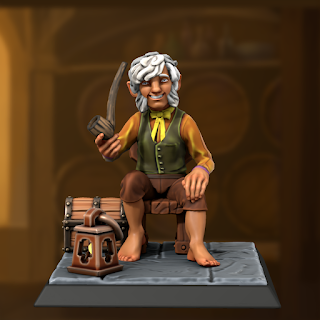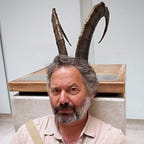Writing | History | Tolkien
Warriors of the Shire
Me Tolkien Nonsense
The Shire is often thought of as a place of bucolic serenity, despite the heroism of the Hobbits in The Lord of the Rings. But is there a trace of the warrior in Hobbit-kind? At the foundation of the Shire a leader was chosen:
“The Hobbits took the land for their own, and they chose from their own chiefs a Thain to hold the authority of the king that was gone” (Prologue, The Lord of the Rings, hereafter LOTR).
Tolkien’s inspiration for this title would have been the Anglo-Saxon thegn or þegn. Historically, the role seems to have originally been a military leader, someone that could be relied upon to maintain a force that could support the king. The initial military aspect is evident in Tolkien’s description:
“The Thain was the master of the Shire-moot, and captain of the Shire-muster and the Hobbitry-in-arms; but as muster and moot were only held in times of emergency, which no longer occurred, the Thainship had ceased to be more than a nominal dignity” (Prologue, LOTR).
In the Scouring of the Shire. The first muster at Bywater produced “more than a hundred sturdy hobbits … with axes, and heavy hammers, and long knives, and stout staves; and a few had hunting-bows.” At the battle of Bywater bows and axes are the only weapons mentioned.
Tolkien clearly wanted to portray the Shire as a peaceful country filled with merry rustics equipped only with agricultural tools, but may have also been thinking of weapons used by that other nation of merry rustics: the English.
The axes would presumably include two-handed felling axes and also one-handed hatchets. Agricultural axes would have heavier heads than fighting axes but would still be quite effective, although Tolkien was probably having romantic thoughts of the Housecarls that defended English King Harold at the Battle of Hastings in 1066 with their two-handed Danish axes.
“Heavy hammers” are not very practical weapons, the god Thor being a possible exception. Another exception is the late medieval two-handed maul beloved of the English archers at battles such as Agincourt. These are unwieldy but are effective against heavily armoured opponents, such as 15th century French knights. War-hammers are a different matter, are much lighter, and are designed for dealing with plate armoured opponents.
Knives that are “long” may be more than just a slightly longer knife otherwise used for whittling by a rustic on their leisure moments. It may possibly be a reference to the Germanic Seax tradition, the weapon that the Saxons were named after. Tolkien would have been very aware of these weapons, and their importance to the early English. The Seax of Beagnoth from the 10th century with it’s inscription in runes saying who owned and who made the knife would probably have been of particular interest to Tolkien.
The long knife or Langes Messer continued to be an important weapon in Germany, and eventually treatises were written about it’s use, demonstrating that the Seax had it’s own martial art associated with it.
The “staves” are of course not just walking sticks but are that quintessential English rustic weapon, the quarterstaff. The great English hero Robin Hood was closely associated with the weapon so it’s qualifications as a definitively English weapon is beyond repute.
That leaves the “hunting bows” and again the Hobbits have probably been associated with the famous English longbow. This is, of course, the most obvious form of martial prowess practiced by Hobbits. It was recorded that “To the help of the king they sent some archers who never returned; and others went also to the battle in which Angmar was overthrown” (LOTR Appendix A). It is said of Hobbits that “They shot well with the bow, for they were keen-eyed and sure at the mark” (Prologue, LOTR).
But what kind of bow would it have been? It is generally assumed that Tolkien tended to think of the mainstay of English archery, the longbow. However a simple wooden bow of the standard Hobbit height would not be very powerful. It is described that “three hobbit-bows twanged and Wormtongue fell dead” and when one of the head ruffians is facing Merry he “fell dead with four arrows in him” (The Scouring of the Shire, LOTR). To make a man “fall dead” as opposed to falling fatally wounded and die of internal bleeding sometime later they must have been quite powerful bows.
An alternative is that they may have had composite bows, made of wood, horn and sinew. In a poem about Earendil it was said that “his bow was made of dragon-horn” (Many Meetings, LOTR). An orc is described as being “armed with a bow of horn” (The Land of Shadow, LOTR). Even a Hobbit-sized composite bow could be a powerful weapon.
However if we consider the Thane and his possible army it is conceivable that they had access to, and knowledge of, more forms of weaponry. One hundred Hobbits march behind Pippin from Tookland, but nothing at all is said about their weaponry. The Thane himself, Pippin’s father, leads most of his army to tackle a large force of men to the south leaving Frodo’s contingent to star in the narrative, and so are not described.
So it might be possible to entertain the thought that the Tooks specifically were a bit more militant than the average Hobbit. Looking at the children of Thain Gerontius “The Old” Took alone there are many names suited to warriors. These names are also references to heroes of legend of which Tolkien would have been aware when he named them. These include “iron-fierce” (Isengrim), “battle-enclosure” (Hildegard), “iron-arm” (Isumbras), “battle-fierce” (Hildigrim), “iron-bold” (Isembold), “battle-ready” (Hildifons), “iron-bright” (Isembard), “battle-sword” (Hildibrand), and “iron-spear” (Isengar). The name of everyone’s favourite Took, Peregrine, means “wanderer” but his father was Paladin, a great-grandchild of the Old Took. A “Paladin” was originally the title of an exceptionally noble and valiant knight from the times of Charlemagne.
Of course it is possible to say “oh they are just old names, possibly derived from another culture” but Tolkien seemed to think a lot about the names he gave people, and the Tooks had the names of warriors, many of them from the tales of the knights of Charlemagne.
But what form of military training would the Shire-muster have practiced? In the Prologue of LOTR it says “they were doughty at bay, and at need could still handle arms.” They are known to be mutually supportive, co-operative folks, but also resistant to change. They are also quite short, of course, so pole-arms would be a good idea. In the history of mediaeval warfare, the use of close-formation pole-arms makes me think of the schiltron. In the many wars between Scotland and England in the medieval period, the schiltron was the close-knit formation of Scottish spearmen that defeated the flower of English chivalry.
If polearms were a component of Hobbit defence, it would be appropriate to include that uniquely English weapon, the billhook or bill. This is especially relevant as the bill started as an agricultural implement that was like a broad heavy knife with a hook. The billhook is particularly useful for building and maintaining hedges. It was simply hafted to a pole to be used in warfare, and was eventually modified with the addition of a spike.
This combination of deadly archery and redoubtable spearmen would actually make a formidable combination, although one that would require regular practice. A schiltron-like formation with archers behind them could probably face down an entire army of goblins. That the entire Shire no longer practiced arms is true, as this is what Tolkien tells us, but he also tells us that the Tooks were a militant lot. As was said in The Scouring of the Shire, it was the Tooks that started the shooting.
All of my ramblings in regard to Tolkien’s legendarium have been put together in a hand-dandy list:


